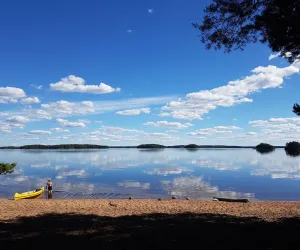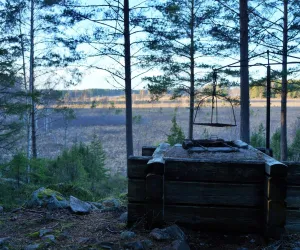The southernmost outpost of Norrland offers wild rapids and a unique natural heritage.
Here, the flatlands of Uppland give way to deep forests, and just a few miles further north, the first mountains rise. Like a string of white pearls, the historic ironworks line the riverbank.
One of Sweden's most beautiful ironworks is nestled along the rapids of the Dalälven River. The water swirls around the white buildings in both summer and winter. The ice never fully manages to tame the lively current. The dense forest provides a serene contrast to the wild rapids. A national park and nature reserve blend seamlessly with the picturesque stone buildings.
Within the ironworks area, nature has been tamed into a stunning park. At its center stands the grand manor house, built in the early 19th century. White stone meets lush greenery. The old industrial buildings now host new ventures, where the clang of hammers has been replaced by the laughter of visitors.
In Gysinge, you don’t have to choose between nature experiences, culture, and good food. Everything is gathered here, passed down through generations. Pair a walk in the national park with visits to the small shops or one of Gysinge’s exhibitions.
Gysinge is located along Route 272, "Tidernas väg," between Uppsala and Sandviken. The area has been designated a UNESCO Biosphere Reserve thanks to its rich natural and cultural heritage.
It's close to here.
| Stockholm | 150 kilometers |
| Uppsala | 75 kilometers |
| Gävle | 50 kilometers |
| Sandviken | 50 kilometers |
| Avesta | 55 kilometers |
| Falun | 85 kilometers |
Gysinge Ironworks
On the ancient pastureland near the roaring Gysingen rapids, Gysinge Ironworks was founded in 1668 by Peder Swensson Printz. Initially, it produced war materials for the Swedish army, using ore sourced from the Dannemora mines. By employing Walloon craftsmen, the ironworks was able to produce high-quality bar iron. Several forges were built, one of which still stands today. In the spring of 2012, the Swedish Forging Championship was held in the "Crooked Forge."
The first manor house was constructed in the 1750s—a yellow wooden mansion in the Carolinian style, crowned with a clock tower. That tower now adorns the roof of the orangery. In the early 1800s, the manor was destroyed by fire, and the clock tower was the only part salvaged.
During the 19th century, Gysinge Ironworks developed into one of the leading ironworks in the country. Construction of the current manor began in 1832. This stone mansion in Gustavian style was designed by architect Carl Christoffer Gjörwell and took eight years to complete. The eastern wing of the manor, dating back to 1775, originally belonged to the old manor.
In 1784, Gysinge Inn and coach station were built to serve coal haulers and travelers.
During the 19th century, a small village emerged on Mattön, just outside the ironworks' grounds. Craftsmen, fishermen, and others not directly employed by the ironworks settled here. A strong grassroots movement grew among the freer inhabitants of Mattön, leaving traces of the Free Church movement visible in Mattön's mission house.
By the late 19th century, the ironworks faced increasing financial difficulties. The owner attempted to resolve these issues by investing in new technology. In 1900, Gysinge became the first in the world to manufacture steel in an electric arc furnace. The Kjellin furnace made steel production both simpler and cheaper. This furnace still stands today and can be viewed next to Jenny and Maud's ironworks shop.
In the early 20th century, Stora Kopparberg purchased Gysinge Ironworks but shut it down after only a few years. Today, the ironworks is divided among three owners: Jula, Fas Holding AB, and Sandviken Municipality.
Färnebofjärden National Park
Experience the national park on foot, by canoe, or by bike.





















Hiking
For those looking for a short walk, Granön is perfect. This wild island is home to many species not naturally found in the area. The trail follows the water, crossing a few picturesque bridges, and the entire loop is just under a kilometer. Be sure to stop by the ancient oak at the far end of the island, said to have healing powers. This gem is located right in the rapids, just a three-minute walk from the ironworks.
The Gästrikeleden trail passes through Gysinge on its route between Hedesunda and Österfärnebo. Heading west, it follows the riverbank through the national park. After 6.5 kilometers, you’ll reach Koversta Gammelby, a village where time has stood still. Unaffected by 19th-century land reforms, Koversta is one of the few Swedish villages that looks just as it did in the 18th century.
If you’re interested in industrial history and beautiful nature, the Railway Bridges are a must-see when visiting Gysinge. Located just 600 meters from the ironworks, these stunning arch bridges were built by Göteborgs Mekaniska in 1900 as part of the Sala-Gävle railway link. Today, they are safe to cross, with walkways and railings. These bridges can mark the start or end of a lovely 8-kilometer hike along the river.
Hiking maps are available at Naturum, the Ironworks Shop, or the Hostel.

Fishing
Gysinge is well-known among anglers. Trout and grayling are the most popular species, but more and more people are discovering the excellent fishing for large perch and pike. The rapids near the ironworks and Sevedskvarn offer fish-rich waters in stunning surroundings.

Kayaking & Canoeing
Rent a kayak and explore the area around Gysinge, or why not have your kayak transported to Färnebofjärden to bypass all the rapids?
